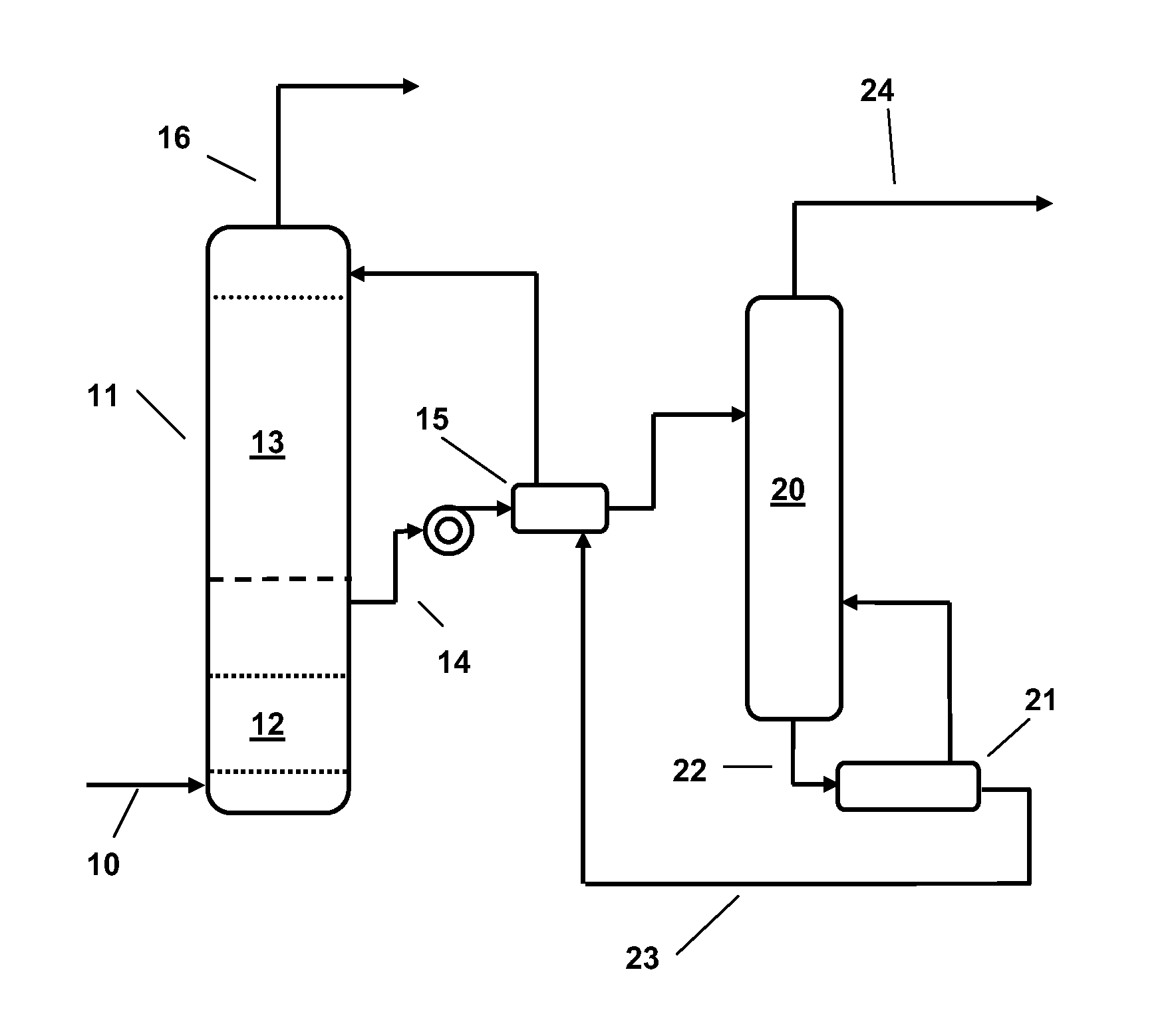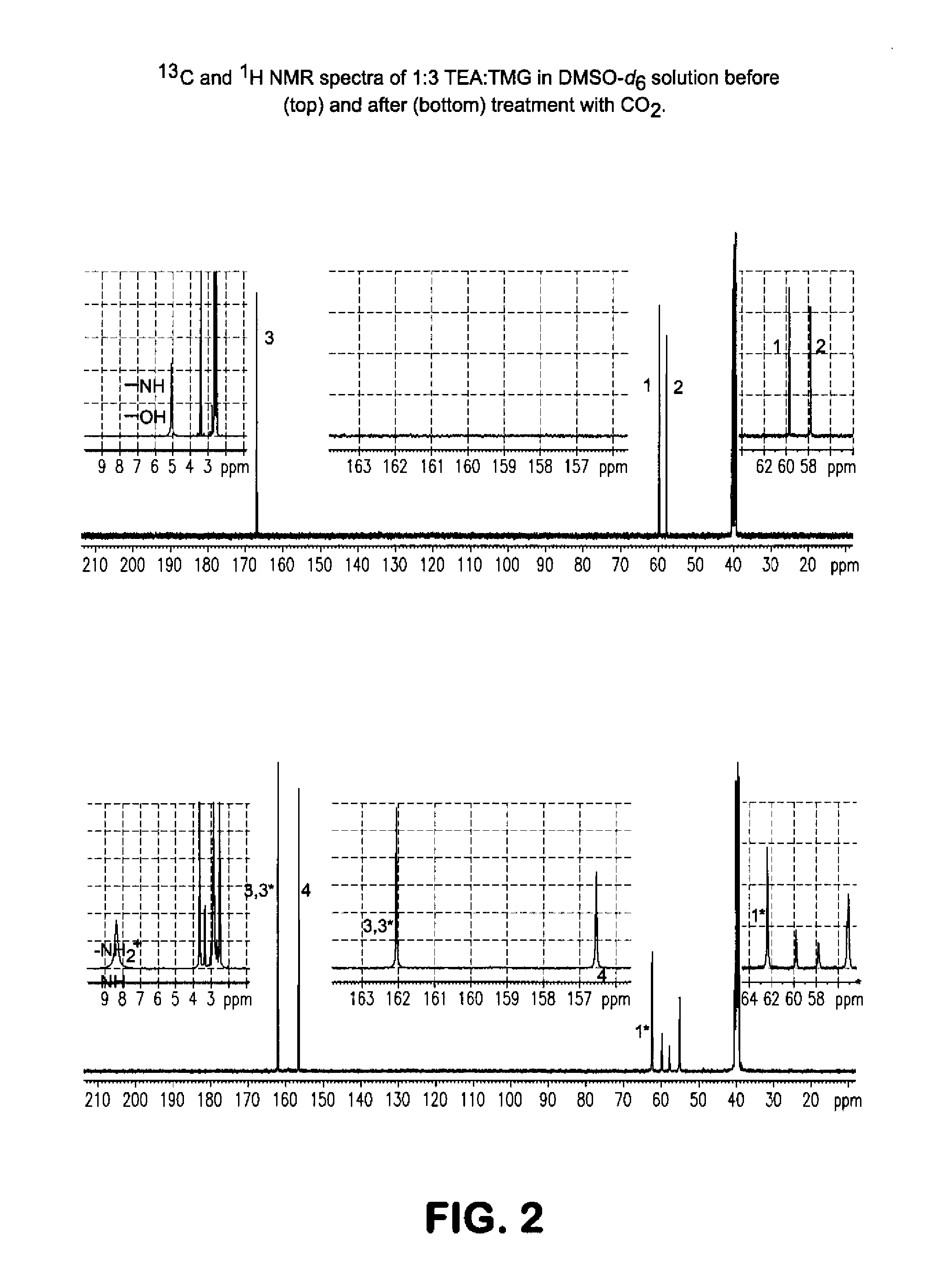Alkanolamine CO2 Scrubbing Process
- Summary
- Abstract
- Description
- Claims
- Application Information
AI Technical Summary
Benefits of technology
Problems solved by technology
Method used
Image
Examples
example 1
O-Carbonative CO2 Uptake with TEA / TMG Sorbent System
[0072]An approximately 30 wt % solution of a ˜1:3 molar mixture of triethanolamine (TEA) and tetramethylguanidine (TMG) was prepared in d6-DMSO in a ˜5 mm NMR tube fitted with a plastic cap. The NMR tube was placed inside a ˜5 mm narrow-bore Bruker Avance III 400 MHz NMR spectrometer with a QNP probe. After initial speciation and quantification of prepared solution (FIG. 2, top), CO2 was bubbled (˜1 atm, or ˜100 kPa partial pressure, at ˜5 cc / min, measured by a Brooks 5896 flow controller) through the room temperature solution outside of the NMR spectrometer for approximately 5 hours. As illustrated in FIG. 2, the initial spectra of the starting materials appeared to change upon CO2 addition. The 13C NMR peak at ˜156.55 ppm (FIG. 2, bottom) appeared to represent a carbonation of alcohol groups of TEA (e.g., —O—COO−). At the same time, the guanidinium C═N resonance appeared to shift to ˜162.05 ppm, and the structural peaks of the TE...
example 2
O-Carbonative CO2 Uptake with DEA / TMG Sorbent System
[0078]An approximately 30 wt % solution of a ˜1:3 molar mixture of diethanolamine (DEA) and tetramethylguanidine (TMG) was prepared in d6-DMSO in a ˜5 mm NMR tube fitted with a plastic cap and capillary dip tube. After initial speciation and quantification of the prepared solution (FIG. 3, top), CO2 was bubbled through the room temperature solution outside of the NMR spectrometer for approximately 2 hours. The keys to the structures in FIG. 3 (top) are shown in FIG. 3A. As illustrated in FIG. 3, the initial spectra of the starting materials appeared to change upon CO2 addition.
[0079]13C NMR peaks at ˜161.78 (overlapping with the guanidinium C═N resonance), ˜159.01, and ˜156.71 ppm are believed to represent reaction products of CO2 with DEA in the presence of the strong base TMG (FIG. 3, bottom). The first peak at ˜161.78 ppm was assigned as a mixed carbamate formed on the secondary amine of DEA (e.g., —N—COO−) with a CO2 loading of...
example 3
O-Carbonative / N-Carboxylative CO2 Uptake with MEA / TMG Sorbent System
[0083]An approximately 50 wt % solution of a ˜1:3 molar mixture of monoethanolamine (MEA) and tetramethylguanidine (TMG) was prepared in d6-DMSO in a ˜5 mm NMR tube fitted with a plastic cap and capillary dip tube. After initial speciation and quantification of prepared solution (FIG. 4, top), CO2 was bubbled through the room temperature solution for approximately 1 hour. As illustrated in FIG. 4, the initial spectra of the starting materials appeared to change upon CO2 addition. The keys to the structures in FIG. 4 (top) are shown in FIG. 4A.
[0084]13C NMR peaks at ˜156.96 and ˜156.80 ppm attributed to O-carbonation (e.g., —O—COO−) products of the alcohol group of MEA molecules in the presence of the strong base TMG (FIG. 4, bottom). Peaks at ˜162.67 and ˜157.93 ppm were attributed to mixed carbamate formation (e.g., —N—COO−) and mixed dicarbamate formation (e.g., −OOC—N—COO−), respectively, on the primary amine of ...
PUM
| Property | Measurement | Unit |
|---|---|---|
| Temperature | aaaaa | aaaaa |
| Temperature | aaaaa | aaaaa |
| Substance count | aaaaa | aaaaa |
Abstract
Description
Claims
Application Information
 Login to View More
Login to View More - R&D
- Intellectual Property
- Life Sciences
- Materials
- Tech Scout
- Unparalleled Data Quality
- Higher Quality Content
- 60% Fewer Hallucinations
Browse by: Latest US Patents, China's latest patents, Technical Efficacy Thesaurus, Application Domain, Technology Topic, Popular Technical Reports.
© 2025 PatSnap. All rights reserved.Legal|Privacy policy|Modern Slavery Act Transparency Statement|Sitemap|About US| Contact US: help@patsnap.com



